 |
|
Starfish
> reef > Marine turtles

|
|  |
|
|
Multi-celled animals (Metazoa) |
REPTILES
About sea snakes
Meeresschildkröten auf Deutsch
|
|
CHORDATA (VERTEBRATES)
Marine turtles

Photos of marine reptiles |
| 
|
| END |
|
Marine turtles
hawksbill turtle - loggerhead
turtle - green sea turtle - olive
Ridley turtle - leatherback turtle
- Australian flatback turtle - Kemp's
ridley - black turtle |
| Marine turtles
(Chelonoidea and Dermochelyoidea)

Swimming behavior |
|
TURTLES IN DANGER OF EXTINCTION
There are only seven species of marine turtles throughout
the world (if you count Chelonia agassizi as a separate species
of the sea turtles, then there are eight species). Unfortunately
their continued existence is very much threatened. Turtles rank
high among the world's endangered species. In many areas people
eat turtle meat and eggs and their oils are used in the cosmetic
industry and their shells are used for combs (Tortoiseshell has
been used to decorate jewelry and other objects). Moreover many
turtles drown accidentally because they get entangled in nets. Bits
of plastic are often mistaken for their favorite food, jellyfishes,
and once swallowed they block the breathing and digestive passages.
Characteristics of marine
turtles
Most species of marine turtle are much larger than
their land relatives. Marine turtles, unlike land turtles cannot
retract their heads completely into their shells. They have a compressed
streamlined shell and broad flattened forelimbs to paddle. They
weight over 500 kg. The span of their forelimbs is over 3m and the
leatherback turtle can be over 2m long.
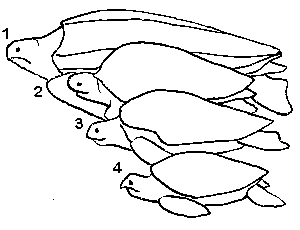
Comparison of the length of marine turtles:
1. Leatherback turtle 120-210cm 2. Green turtle 80-120cm 3. Loggerhead
turtle 70-110cm 4. Hawksbill turtle 55-95 cm
Ecology and range of marine
turtles
Turtles are found in around the world. Most migrate
over long distances to reach their favored breeding sites. Turtles
can dive down to depths of over 1500 meter.
Behavior of marine turtles
Turtles breathe air, but they spend as much as 3
hours submerged. They prefer open water, but are occasionally encountered
close to reefs. Most turtles are mainly carnivores and feed on jellyfish,
tuncates (ascidians, sea squirts), sponges (one of a few animals
that eat them), soft corals, crabs, squids and fishes. Some turtles
also feed on seagrasses and algae.
Breeding occurs in cycles that vary from 1-5 years.
Turtles live and mate at sea, but during reproduction season the
females return to the beach on which they themselves emerged as
hatchlings to lay their eggs. Turtles are built for swimming, so
they appear very slow and clumsy when emerging from the sea. A single
female usually lays several batches of eggs at 2-3 weeks intervals.
A hole is excavated with the hind flippers and about 50-150 eggs
are deposited. The turtle immediately covers them with a layer of
sand. Mucus streams from her eyes to moisten them. Finally after
about 8 hours she returns to the sea.
Incubation time is about 2 months. The heat of the
sun incubates the eggs. If temperatures rise above 29.9° C
the embryos become female, lower temperatures result in male hatchlings.
Eggs hatch usually at night. After emerging from the nest the young
turtles must literally run for their live. Sharks and other large
fishes as well as birds pick them off while they dash to the sea.
|
Photos of marine turtles (photo
collection) click for enlargement
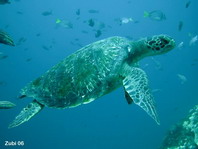
INFO - Green Sea turtle (Chelonia mydas)
|
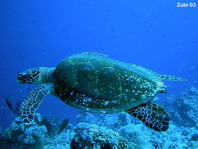
INFO - Hawksbill turtle (Eretmochelys imbricata) |
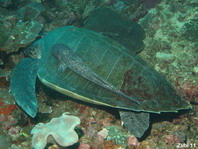
Olive Ridley turtle - Lepidochelys olivacea
|
| 
Green Sea Turtle - Chelonia mydas
|
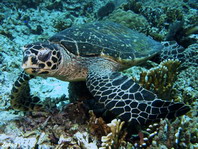
Hawksbill Turtle - Eretmochelys imbricata
|
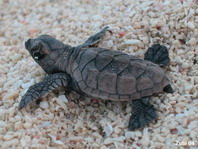
Baby turtle, just hatched |

|
How to distinguish
the 7 species of marine turtles?
|
| 1. Hawksbill turtle
(Eretmochelys imbricata)



|
|
- Color: dark, greenish-brown, juveniles have
the "tortoiseshell" pattern
- Length: 55-95 cm
- Weight: around 55 kg
- 4 pairs of overlapping, sharp scutes on the edges of its shell
- Particularly narrow jaw, upper jaw is overhanging
- Front flippers with 2 claws on each
- Males: long and thick tails, bigger claws and more concave plastron
- Diet: Sponges, tunicates (ascidians, sea squirts),
mollusks and sea urchins
- Distribution: all oceans, tropical waters
- Habitat: reef areas and rocky coastal areas
- Listed as an endangered species
 |
Key to the identification of the
Hawksbill turtle (Eretmochelys imbricata):
a) 4 overlapping scutes
b) Curved beak with distinct overbite
c) 2 claws on the front flippers
|
|
| 2. Loggerhead turtle(Caretta
caretta)
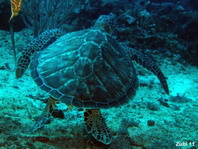
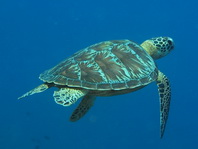

|
|
- Color: reddish brown
- Length: 55-95 cm
- Weight: about 55 kg
- Pairs of coastal and vertebral scutes, 3 pairs of inframarginal
scutes
- First coastal plate touches neck
- Large heads and powerful jaw
- 2 claws each on fore-flippers
- Males: narrower shells and longer and thicker tails
- Diet: Crabs, mollusks, shrimp and jellyfish
- Distribution: all oceans, primarily temperate waters
- Habitat: near shore but also open ocean
- Listed as a threatened species
 |
Key to the identification of the Loggerhead turtle (Caretta
caretta) :
a) Inter prefrontal scute (and 2 postorbital scutes)
b) 5 lateral scutes
c) 2 claws on the front flippers
|
|
| 3. Green Sea turtle
(Chelonia mydas)


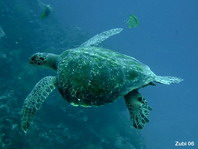
|
|
- Color: brown (common name derived from the color
of its green fat). Hatchlings almost black, but lighten in color
within their first year
- Length: 80-120cm
- Weight: 130-250 kg
- 4 coastal scutes, none of which overlap
- Pair of scales at the front of head
- Fore-flippers one claw each
- Diet: as juveniles: shellfish, jellyfish and
other marine creatures
- Diet: as adults: sea grasses and algae
- Distribution: Mediterranean, Atlantic, Golf of Mexico,
Argentinean coast, Indo pacific
- Habitat: bays and coastal waters
- Over hunted, because of the use of its flesh in turtle soup
 |
Key to the identification of the
Green Sea turtle (Chelonia mydas):
a) Lower jaw serated
b) 1 claw on front flipper
c) 4 coastal scutes, none of which overlap |
|
| 4. Olive
Ridley turtle
(Lepidochelys olivacea)


|
|
- Color: grayish-brown as juveniles, olive green
as adults
- Length: 50-75cm (smallest of the ocean-going
turtles)
- Weight: about 50 kg
- 6 - 9 costal scutes, number may be asymmetrical
- 5 pairs of coastal plates and 3 or 4 inframarginal scutes. Inframarginal
scutes have 1 pore near the back edge.
- First coastal plate touches neck
- Almost circular shell
- Distribution: tropical waters of Pacific, Indian
and South Atlantic Oceans
- Habitat: off shore in surface waters, can dive to depths
of 150m
- Diet: Crabs, mollusks, shrimp and jellyfish
- Probably the most endangered species of sea
turtle in the world
 |
Key to the identification of the
Olive Ridley turtle (Lepidochelys olivacea):
a) 1 or 2 claws on front and rear flippers
b) 6 to 9 lateral scutes |
|
| 5. Leatherback turtle
(Dermochelys coriacea)

|
|
- Color: black to dark blue, with occasionally
patches of white or pink
- Length: 120-210cm (world's largest sea turtle)
- Weight: up to 900kg
- Smooth, leather-like skin in which are embedded thousands of
tiny bones. 7 raised ridges
- Flippers with no claws
- Distribution: all oceans, subarctic to tropical.
Likes to migrate over large distances (up to 5000km)
- Habitat: pelagic, deep diver (1500 meter)
- Diet: Primarily jellyfish, squids and marine
fauna
- Ability to maintain their internal body temperature much higher
than the surrounding water. Can tolerate a wide range of temperatures.
- Endangered species
 |
Key to the identification of the
Leatherback turtle (Dermochelys coriacea):
a) Tapered, leathery with 5 ridges (no scales)
b) Tooth-like notch on either side of upper jaw
c) No claws |
|
| 6.
Australian flatback turtle
(Natator depressus) |
|
- Color: olive grey
- Length: 97 cm
- Weight: 84 kg
- Shell is very flat
- 4 costal scutes
- Diet: Invertebrates, seagrass
- Range: northern tropical coastal Australia
- Habitat: inshore waters, bays, coastal coral
reef
 |
Key to the identification of the
Australian flatback turtle (Natator depressus):
a) Northern Australia or the Gulf of Papua New Guinea
b) Round and very flat carpace
c) Margins folded and covered by thin, non-overlapping waxy
scutes
|
|
| 7.
Kemp's ridley
(Lepidochelys kempii) |
|
- Color: gray to light olive green
- Length: up to 70 cm
- Weight: up to 45kg
- 5 lateral scutes
- 1 claw on front flipper, rear flippers have 1 or 2 claws
- Diet: crustaceans, fish, invertebrates
- Distribution: Gulf of Mexico (95% of the female lie their
eggs in a 17km wide coastal strip, Rancho Nuevo)
- Listed as Critically Endangered
 |
Key to the identification of the
Kemp's ridley (Lepidochelys kempii):
a) Gulf of Mexico and eastern USA
b) 5 lateral scutes
c) 1 claw on front flipper and 1 or 2 claws on rear
flipper |
|
| Black turtle
(Chelonia agassizi) |
|
- The status of the Black Turtle or east Pacific Green Turtle remains
uncertain. It might be a subspecies of the Green Sea Turtle (Chelonia
mydas)
- Color: black or grayish with black markings
- Length: Up to 117cm
- Weight: up to 126kg
- Serrated jaw
- Fore-flippers one claw each
- Diet: Seagrass, algea, mangroves shoots
- Range: East Pacific Ocean
- Habitat: Bays and coastal waters
|
| 
|
| |
|
Turtles and tourism
Please quietly observe a nesting turtle from a distance. Do not shine
any lights on or around her - she may abandon her effort to nest.
No flash photography. Stay behind the turtle so that she cannot see
you. Do not harass a turtle by touching her or prodding her to move.
Stay out of the way as she crawls back to the water.
Turtle hatcheries are often a tourist attraction. But not all hatcheries
treat their turtles so well. Please notice, that turtles usually hatch
during the night and not during the day. Hatchlings should then be
able to reach the ocean as quickly as possible. If kept in tanks and
released during the day the hatchling may loose their ability to "smell"
their birthplace (and return to lay eggs later in their lifecircle)
and they are more likely to be picked up and eaten by birds and large
fish. |
| 
|
| TOP |
|
hawksbill turtle - loggerhead
turtle - green sea turtle - olive
Ridley turtle - leatherback
turtle - Australian flatback turtle - Kemp's
ridley - black turtle |
| 
LINKS ABOUT
REPTILES
 |


























